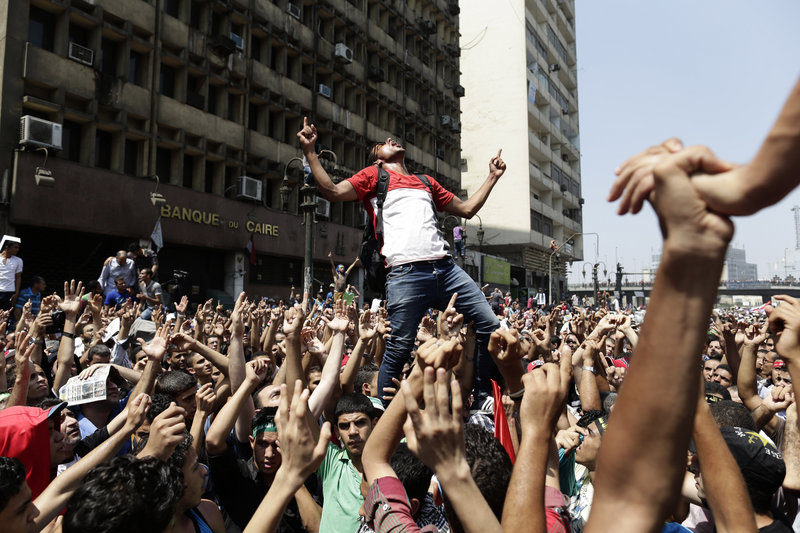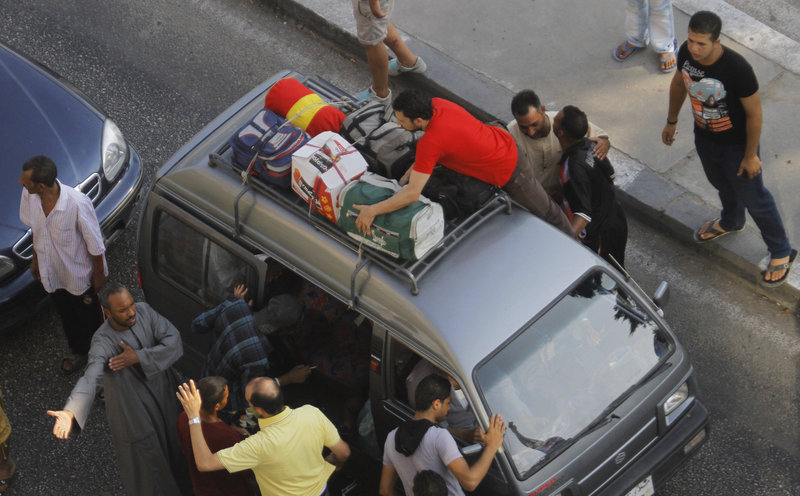CAIRO – Egypt’s capital descended into chaos Friday as vigilantes at neighborhood checkpoints battled Muslim Brotherhood-led protesters denouncing the ouster of President Mohammed Morsi and a deadly crackdown. The fiercest street clashes the city has seen in more than two years of turmoil left more than 60 people dead, including several policemen.
The sight of residents firing at one another marked a dark turn in the conflict, as civilians armed with pistols and assault rifles clashed with protesters taking part in what the Muslim Brotherhood called a “Day of Rage,” ignited by anger at security forces for clearing two sit-in demonstrations Wednesday in clashes that killed more than 600 people.
Military helicopters circled overhead as residents furious with the Brotherhood protests pelted them with rocks and glass bottles. The two sides also fired on one another, sparking running street battles throughout the capital’s residential neighborhoods.
There was little hope that an evening curfew would curb the violence as the Muslim Brotherhood called on supporters of the country’s ousted Islamist president, Mohammed Morsi, to stage daily protests.
BATTLE ON BRIDGE
Unlike in past clashes between protesters and police, residents and possibly police in civilian clothing battled those participating in the Brotherhood-led marches. There were few police in uniform to be seen as neighborhood watchdogs and pro-Morsi protesters fired at one another for hours on a bridge that crosses over Cairo’s Zamalek district, an upscale island neighborhood where many foreigners and ambassadors reside.
Across the country, at least 56 civilians were killed, along with eight police officers, security officials said. They spoke on condition of anonymity in line with regulations.
The violence erupted shortly after midday weekly prayers when tens of thousands of Brotherhood supporters answered the group’s call to protest across Egypt in defiance of a military-imposed state of emergency following the bloodshed earlier this week.
Armed civilians manned impromptu checkpoints throughout the capital, banning Brotherhood marches from approaching and frisking anyone wanting to pass through. At one checkpoint, residents barred ambulances and cars carrying wounded from Cairo’s main battleground, Ramses Square, from reaching a hospital.
DANGEROUS DIVISIONS
The scenes highlighted how dangerous the divisions in Egypt have become. At least nine police stations were attacked Friday, officials said. Egypt’s police force was rocked by the country’s 2011 uprising that ousted longtime leader Hosni Mubarak from power and has not fully recovered since.
On Thursday, the Interior Ministry said it had authorized the use of deadly force against anyone targeting police and state institutions. But the threat appeared not to intimidate protesters.
The Brotherhood-led marches in Cairo headed toward Ramses Square, near the country’s main train station. The area is near Tahrir Square, where the army put up barbed wire and deployed 30 tanks outside the Cairo Museum overlooking the square as a buffer between the protesters and a small anti-Brotherhood encampment in the square.
Several of the protesters were seen writing their names and relatives’ phone numbers on one another’s chests and undershirts in case they were to die in Friday’s clashes.
Tawfik Dessouki, a Brotherhood supporter, said he was ready to fight for “democracy” and against the military’s ouster of Morsi.
“I am here for the blood of the people who died. We didn’t have a revolution to go back to a police and military state again and to be killed by the state,” he said during a march headed toward Ramses Square.
At least 12 people were killed near the square after police fired on protesters. Some appeared to be trying to attack a nearby police station, security officials said. Inside Al-Fath mosque near Ramses Square, where the Brotherhood urged its Cairo supporters to converge, blood-soaked bodies with bullets to the head and chest lay next to one another.
Associated Press photographers saw many of the dead inside the mosque-turned-morgue, which was also acting as a field hospital where the wounded were being wheeled in on wooden crates. One corpse had a name and phone number scribbled on the chest.
The upper floors of a commercial building towering over Ramses Square caught fire later in the day, with flames engulfing it for hours. It was not immediately clear what caused the fire at the building housing the Arab Contractors’ construction company, but no injuries were reported.
VIOLENCE BEYOND CAIRO
Similar scenes played out in Egypt’s second-largest city of Alexandria, where at least 10 people were killed in clashes between protesters and their rivals, according to a security official. Violence was also fierce in the province of Fayoum, just west of Cairo, where 11 people died during an attempt to storm the main security building there.
Fighting also broke out in at least five other provinces.
In the southern province of Minya, two churches were attacked by protesters, security officials said. At churches across the country, residents formed human chains to protect them from further assaults, and a civilian was killed while trying to protect a church in Sohag, south of Cairo, authorities said.
Many of Morsi’s supporters have voiced criticism at Egypt’s Christian minority for largely supporting the military’s decision to oust him from office, and dozens of churches have been attacked this week.
Egypt, the Arab world’s most populous nation, has been in turmoil since Morsi was removed from power by the military on July 3.
Send questions/comments to the editors.




Success. Please wait for the page to reload. If the page does not reload within 5 seconds, please refresh the page.
Enter your email and password to access comments.
Hi, to comment on stories you must . This profile is in addition to your subscription and website login.
Already have a commenting profile? .
Invalid username/password.
Please check your email to confirm and complete your registration.
Only subscribers are eligible to post comments. Please subscribe or login first for digital access. Here’s why.
Use the form below to reset your password. When you've submitted your account email, we will send an email with a reset code.